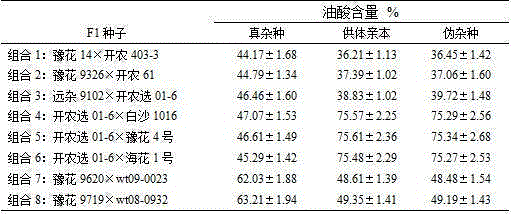Nondestructive detection method for identifying F1 seed true/false between species of peanut with high oleic acid content and peanut with normal oleic acid content
A technology of damage detection and high oleic acid, applied in the field of agricultural bioengineering, can solve problems affecting seed preservation and germination, seed damage, etc., and achieve the effects of improving breeding efficiency, low cost, and reducing workload
- Summary
- Abstract
- Description
- Claims
- Application Information
AI Technical Summary
Problems solved by technology
Method used
Image
Examples
Embodiment 1
[0025] Example 1 , a non-destructive detection method for distinguishing the authenticity of F1 seeds between high oleic acid and common oleic acid peanut varieties, comprising the following steps:
[0026] (1) Harvest all F from the hybrid combination between high oleic acid and normal oleic acid 1 Seeds and seeds selfed by the female parent under the same planting conditions;
[0027] (2) Using near-infrared spectroscopy to measure the female parent and F of a single grain, respectively 1 Oleic acid content of seeds. The female parent measures the oleic acid content of 10-20 seeds, and gets the average value for later use;
[0028] The steps for determining the content of oleic acid with near-infrared spectroscopy: turn on the power of the near-infrared spectroscopy analyzer (DA7200DiodeArrayAnalyzer), and preheat it for half an hour; put the peanut seeds in the center of the sample measuring platform, and select the pre-stored oleic acid analysis Spectrum curve, click ...
Embodiment 2
[0033] Example 2: Using molecular markers to identify true and false hybrids in hybrid seeds.
[0034] Harvest the hybrid F of the hybrid combination wt09-0023×Yuanza 9102 and Yuanza 9102×wt09-0023 respectively 1 seeds, for each F 1 Seed numbering, a small amount of tissue was cut from the far embryonic end of the seed to extract DNA. The FAD2 gene of Yuanza 9102 (ah FAD2A and ah FAD2B ) is AABB, and the genotype of the FAD2 gene of wt09-0023 is aabb, so the genotype of the FAD2 gene of the above two combinations of true hybrid seeds is AaBb; The type is aabb, and the genotype of the pseudo-hybrid in the combination of 9102×wt09-0023 is AABB.
[0035] Each F can be obtained by sequencing 1 The genotype of the seed, which distinguishes true and false hybrids based on genotype. F1 Seed DNA was used as a template, and primers aF19 / R3 and bF19 / R3 (Patel, 2004) were used for PCR, and genotypes could be distinguished according to the sequencing peaks of PCR products.
[00...
Embodiment 3
[0038] Embodiment 3, Comparison of Determination of Oleic Acid Content in Peanut Seeds by Near Infrared Spectroscopy and Gas Chromatography
PUM
 Login to View More
Login to View More Abstract
Description
Claims
Application Information
 Login to View More
Login to View More - R&D
- Intellectual Property
- Life Sciences
- Materials
- Tech Scout
- Unparalleled Data Quality
- Higher Quality Content
- 60% Fewer Hallucinations
Browse by: Latest US Patents, China's latest patents, Technical Efficacy Thesaurus, Application Domain, Technology Topic, Popular Technical Reports.
© 2025 PatSnap. All rights reserved.Legal|Privacy policy|Modern Slavery Act Transparency Statement|Sitemap|About US| Contact US: help@patsnap.com



